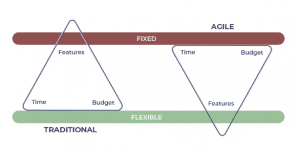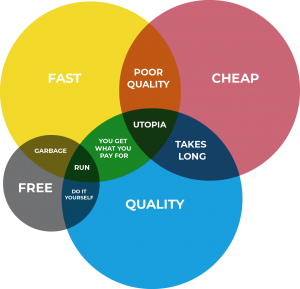Before turning your back on Agile, read this
I’ve often heard that Agile transformation implies a paradigm shift, but what is a paradigm and why does it imply such a change? Anyone who has successfully made the shift can tell you that it’s not just about applying a set of practices like implementing ceremonies, but it’s about changing the way you see the world.
Let’s take a look at one definition of paradigm:
Paradigm – (noun) Model of work or pattern shared by a scientific community whose members agree on what is a legitimate problem and what is a legitimate solution to the problem, so they share basic concepts, procedures, etc.
I think that in addition to that definition, it can be conceived as a way of seeing the world. Once you start to see things through the lens of Agile, it no longer makes sense to go back. Agile becomes the normalized way of seeing things for those who have made the switch.
Something very important that took me a while to understand, is that with agile methodologies the paradigm of estimation and planning changes as well.
An Important Reversal
Instead of setting the project scope and then determining a timeline and budget, Agile teams will set the time and budget and then estimate the scope of work that could be accomplished.
The following image reflects this clearly, showing what is fixed and what is flexible in a traditional waterfall vs agile environment:


As agile planning is value driven, this also implies the tradeoffs in the relationships between cost, quality and delivery time as shown below:


Adopt Agile Whole-Heartedly or Not at All
When working in an agile transformation, take concrete actions to focus on raising everyone’s awareness as well as provide the required training needed to adopt the practices that can promote this transformation. The important thing is to make it clear to all that it’s not just about changing practices. There’s far more to it.
For example, agile software development has a manifesto, values, pillars and principles that, for those who know the benefits of Agile, regard them as more important than any concrete practice.
I’ve seen people broach the topic of the “dark side” of Agile, but what I’ve noticed is that the real reason why it goes wrong is that practices are not distinguished from values.
Teams can misuse agile practices by failing to take into account the importance of their underlying principles. When the new practices they adopt fail, it can be all too easy to blame Agile and refuse to complete the transformation. But, with all the benefits that agile delivers to teams, (once it’s fully ingrained), make it all worth it. Agile development promotes risk reduction, better leadership, a continuous output of value, scalability, and early feedback.
Thus, my message to you is to treat your transformation with great care and understand that it goes far deeper than processes.
Teams have to endure a complete mindset shift in order not to fail in their transformations and be left with misguided conclusions surrounding Agile.
What do you think? Have you seen an agile transformation fail?
Recommended for You
Can There Be Testers in Scrum?
The 3 Fast and Furious Agile C’s


Federico Toledo, Chief Quality Officer at Abstracta
Related Posts
How Does Scrum Help in a Shift Left Strategy?
How important are agile methodologies for Shift Left Testing? What are the benefits of Scrum in this path? Find out everything in this article by Gabriel Ledesma. By Gabriel Ledesma Is it possible to achieve the goals of Shift Left Testing with traditional methodologies in…
Scrum, a Paradigm Shift for Software Testing
From waterfall to agile methodologies. What are the differences between Scrum and other frameworks? How does it represent a paradigm shift in software testing and quality? Find it out in this article written by Gabriel Ledesma, Leadership Coach at Abstracta and co-founder of the agile…
Search
Contents
Categories
- Acceptance testing
- Accessibility Testing
- AI
- API Testing
- Development
- DevOps
- Fintech
- Functional Software Testing
- Healthtech
- Mobile Testing
- Observability Testing
- Partners
- Performance Testing
- Press
- Quallity Engineering
- Security Testing
- Software Quality
- Software Testing
- Test Automation
- Testing Strategy
- Testing Tools
- Work Culture





